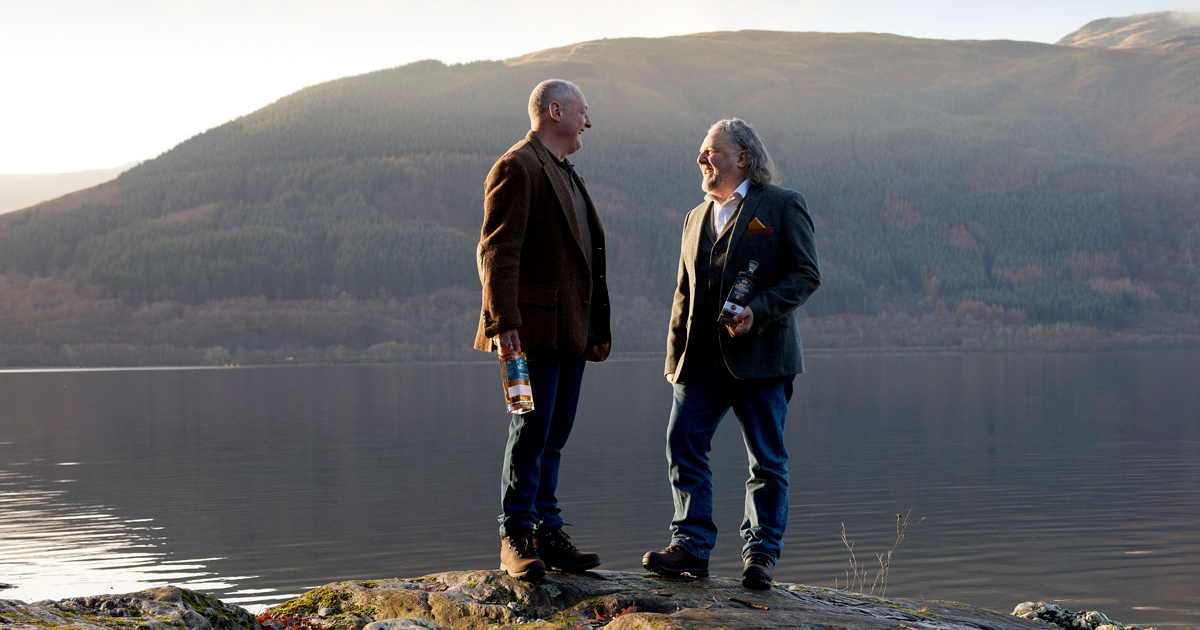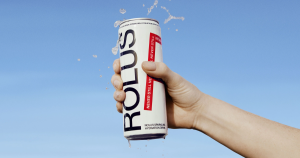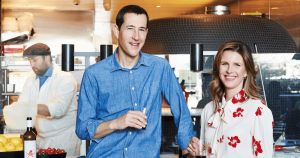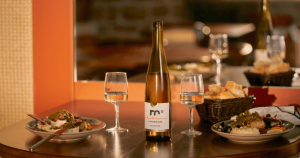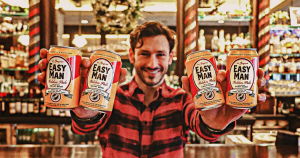Spirits of Virtue started with a dad trying to prove his son wrong. Now, the Scottish company distributes its seven non-alc brands everywhere from Japan to the United States. In this interview, co-founder Roddy Nicoll describes the ups and downs of building a “mini Diageo,” from rescuing his company from the brink of collapse during COVID to entering markets as diverse as Asia and the Middle East. Roddy’s is a story of risk-taking and determination, guided always by his intuition and vision for what the future of drinking can be.
Roddy, you launched Spirits of Virtue before the recent rise of alcohol alternatives. Could you share what initially drew you to this space before it became so popular?
I’m a serial entrepreneur. If you say that in America, there are probably another three or four in the room. In Scotland, if you say that, everybody kind of looks at you. There’s a very parochial mindset here: “don’t step outside your box.” I had a confectionery company, worked in soft drinks, and then I was approached by another company making ingredients for Prosecco—the alcoholic version.
That’s where my head was. Additionally, my son is on the autism spectrum. We were hosting a big family party, and I was enjoying a gin and tonic because I occasionally indulge in alcoholic drinks. Then, he caught me with one of those questions. He has a very linear thought process. He asked, “Dad, why do you drink gin and tonics?” I could see it coming. I answered, “I like it for the taste,” and he retorted, “no, I think you like it for the alcohol.”
I definitely just liked it for the taste. So, I thought to myself, “why don’t I make gin without alcohol and turn it into a whole venture?” I was unaware of Seedlip and what Ben [Branson] was doing in those early days. Spirits of Virtue started with a dad trying to prove his son wrong. I thought, “I can do this.” I had a still, and I was messing about with something called shrubs. As a tinkerer and a restless person, I’ve always got jars of things for mixing and such, and it drives my wife up the wall. That’s how it all started.
It took me a lot longer than I expected. My younger brother Kerr, who is also a co-founder, encouraged me to scale. So, we invested in a big stand at a food and beverage trade show in Birmingham, England. We took a significant risk by gambling with the last of the money that we had. The first people to visit our stand were from UK supermarket giant Asda, which was owned by Walmart at the time, who said, “come and see us.” Subsequently, a major supermarket chain called Ocado also expressed interest.
The last and most interesting visitor was the HFA, which is the Halal Authority in the UK. When we explained that our zero proof products have never been de-alcoholized, they said, “have you realized the implications of what you’ve done?” I thought, “wow, this is it. This opens up the Middle Eastern and Asian market. We’ve made it. We’ve hit the motherlode.” I sold my confectionery company and threw everything I had into Spirits of Virtue. That was about six and a half years ago. It seems like a long time now, because here we are with non-alcoholic beverages exploding across the globe.
Today, we’re experienced in the game, yet the company is still in its infancy. It’s fantastic. It’s the most amazing sector to work in because there are no rules, no agreed methods of manufacturing, and labeling is still in its infancy.
You also ambitiously decided to launch multiple brands. Can you discuss why you chose to not only create a non-alcoholic gin but also develop a diverse range of products? What motivated you to expand into various sub-brands within the spirits category despite the challenges involved?
I’ve always believed that “if you build it, they will come.” In other words, rather than being analytical, my decisions are more intuitive; it’s a gut instinct. I’ll look at the scenario and say, “I think that’s going to work.” You can spend so long trying to look for data to support that position, but I’m a believer in intuition. You chase that ideal, and off you go. There are just challenges to overcome.
I thought: “if we’re going to make a gin, let’s make it smell and taste like gin.” There were botanical products on the market. But there weren’t analogues of alcohol. It’s my long-held view that if somebody is a bourbon drinker and they want to move to non-alcoholic bourbon, surely they will look for something that smells, tastes, and looks like bourbon because they feel comfortable in that space. Today, the market’s catching up. But, six years ago, I had to persuade my investors that that’s where we were going. Everyone else was on a different journey.
We started with non-alcoholic gin. Then, it was just a given; we’re in Scotland, we’re proud Scots, we had to look at whiskey. Suddenly, it’s “oh, you’ve got to have rum,” and before we knew it, we were looking at a full portfolio.
Now, I’ve got seven brands in the whole portfolio, and each brand is in its own bespoke glass. My investors and shareholders are with us despite the challenges. When it comes to market activation, for example, I don’t have one brand to look after, I have seven. The upside is that, if I walk into a buyer now and they don’t like my gin alternative, they might like my non-alc bourbon or vodka. If I enter the Finnish market, they’ll want my vodka. If I enter the Australian market, they’ll want my gin. Or, if I go to the States, they’ll want my non-alc bourbon. We’ve always got a non-alc product that will lead in any given marketplace. I’ve always envisioned Spirits of Virtue as a mini Diageo for the non-alcoholic space. That was the dream. So, we said, “let’s build that whole portfolio.”
Looking at your portfolio today, I would say you’re well on your way toward becoming the mini Diageo for non-alc. Your vodka in particular piqued my interest. Non-alc brands don’t typically attempt to replicate vodka. Why did you decided to do so, and how does that formulation process compare to something like gin?
Many brands focus on gin. There are many different reasons for that; it’s a very pronounced flavor, and its pairing partner, tonic, is used 99% of the time. When we turned our attention to the vodka, it was much more about mixology and on-premise application than direct-to-consumer. This allowed us to introduce new flavors, such as vanilla, citron, and berries.
We looked at how we could complete the circle for the bartender and, ultimately, for anyone wanting to recreate the cocktail list. That was our starting point. But, of course, we had to start with a classic vodka. There was a lot of head-scratching because every vodka company has worked as hard as possible with multiple-stage distillations and charcoals to remove any flavor or taste. What we had to do was look for tiny traces and figure out how we could emphasize them. I won’t give away any secrets here, but we found two vegetal masses that we use to replicate the aroma of vodka.
The non-alc vodka we created is called USKO—a Finnish term meaning “belief’—and it’s been in our portfolio since 2019. Initially, it didn’t really get much traction commercially because everybody thought, “vodka, non-alcoholic, it’s a hard sell, Roddy.” And it was. But, this year, USKO listed in Alko, which is the Finnish government’s monopoly for the distribution of alcoholic beverages. Now, to sell non-alcoholic vodka to the Finns using a name borrowed from them, it’s quite a feather in our cap. We also put it on Amazon USA this year just to see what happened, and it sold out. We had to bring in half a dozen pallets. It’s gone crazy.
A lot of brands stay away from it. It’s not an easy product to make. But I was confident in the correlation between people who like an alcoholic brand and then seek a non-alcoholic brand—you’re a vodka drinker and you’re looking to transition. We all know that’s the market trend. Those are the cues.
Going back to your broader portfolio for a moment: all of your products are made with special water. Can you talk a little bit more about this water and how it’s different?
We are very, very lucky that we started the company in Scotland. No disrespect to the Japanese or the lovely people of Tennessee, but if you want to make good whiskey, you make it in Scotland. The water’s perfect. We have lots of it. The particular water we use is even special for Scotland. It’s from the Royal Deeside, right next to the royal Balmoral Estate, and it takes 50 years to percolate through the granite mountains of the Cairngorms. What makes it so unique is that it has smaller sized H2O clusters, which means it really holds onto flavors, and it has a low mineral content too. In years gone by, royalty used to bathe in the same spring for its restorative powers.
I wanted to secure the very, very best water I could. If you wanted to make a superior single malt or a hyper premium gin and you were in Scotland, this is the water you would use.
As you look to enter the American market, is there anything that you’re anticipating will be quite different from selling in Europe?
The UK market is probably the most developed no-and-low market in the world. For instance, the seven big retailers all have dedicated no-and-low buying teams. So the public’s awareness of those products is at a much, much higher level. There’s also much more competition.
What we bring to the American market is that experience. We’ve made a lot of mistakes—we all have. Now, we can bring those learnings to the American side. We’ve got the provenance, the presentation, the packaging, and the price. If they’re in perfect balance, you enter the market at a point that drives participation and purchase.
We’ve entered the American market at a price point that I believe the consumer is comfortable with. The water and the botanicals we use are second to none. We have no artificial colors and flavors, no artificial sweeteners, no sugar. We’re gluten-free, vegetarian, vegan, halal. The glass is 96% recycled. These are all lessons we learned as we progressed. These are things we know the consumer cares about. As we enter the American market, you all benefit from the evolution our brands have gone through over the past six years.
I’ve always wondered: why do you think the UK led the world in the no-and-low space? Many expect American companies to be at the forefront of innovation. Here’s an example where, generally speaking, they were at least five years behind the UK. Why do you think that was?
The ecosystem in America is far more developed for entrepreneurs in terms of support, funding, etc.
But America is 50 different territories stitched together in a big patchwork, all with their own rules. It’s very difficult, actually, to get a product into the US and to get it distributed. The UK is smaller. It has a population of around 67 million compared to America’s 330 million. In the UK, you can hit most of the big retailers and the big distributors with a dozen appointments. If you did that in one state in America, you still couldn’t cover it. It’s just a scale problem.
COVID had an awful lot to do with accelerating non-alc in both countries.
Can you share a bit about COVID’s impact on your business?
Originally, my brother and I had co-packers making our product for us. We were going down that traditional route. For a new spirit brand, it’s: build your presence on-premise, get liquid on lips, create disciples. Then, they go out and look for it outside of their favorite bar, club, or restaurant. People will be more adventurous with a single drink at a meal rather than buy a whole bottle. Then, they’ll look for specialist retail and e-commerce. Eventually, you get into the supermarket. That was our plan.
Of course, with COVID, everything closed and all our orders got canceled. My brother and I were sitting looking at each other saying, “we’re going to go out of business here. This is the end of days.”
Luckily, we’d made some product for two big supermarkets, Asda and Lidl. At the beginning of one week, all of our other orders were canceled. By the middle of that week, Asda rang us and asked, “do you have anything sitting around we can put on our shelves?” They placed these huge orders because, with the first wave of COVID in the UK, supermarkets ran out of anything to put on the shelves. The buyers were saying: “we will buy anything, anything at all.” So, as our co-packer was closing down, in this madness we decided to get a factory.
My brother and I built the interior of the factory during COVID with no workmen. No help. We worked 18 hours a day. By the time we came out of COVID, we had these relationships with the retailers. All these lovely buyers in retail who used to be data analysts suddenly became a little bit more gung-ho.
Wow, really turning a challenge into an opportunity. Roddy, looking ahead now, you’ve had such an amazing journey to date. What’s next?
When I read somebody’s book about how they made it, I’m fascinated. But I do think that sometimes you look back with rose-tinted glasses and you start to analyze decisions that you made and instantly you say, “well, I understood this or that thing.”
I wake up each morning and I play the game as it presents itself to me. I’d love to say that there was always a clear strategy for moving forward, but what happens is that opportunities open up and my team captures them. I have the best team. Some of us are in our mid-50s and we’ve got lots of scar tissue. But we’ve still got the energy to get up every day. And some are young, fresh faces who are our legs.
At the moment, we’re working on some fantastic aperitivos that will be a fantastic addition to the market. We’re very lucky to have industry expert Angela Mount on our team and working on this. She’s an exceptional blender who’s been in the drinks industry all of her life.
Then, we’re focused on taking the portfolio global. Going into North America is a huge task, a massive task. It will take years. I’m just back from Korea, Japan, and China—virgin territory. I’m back to where I was six years ago, explaining to people that we’re making whiskey with no alcohol in it and they’re asking me the same questions: “why would you do that? What’s the purpose of that?” My arguments now are much more reasoned because I’ve been making them for six years.
Our Glen Dochus non-alc whiskey brand is about to launch in Japan, in Saudi, and in North America. For my marketing team to create a message that works in midtown Osaka, downtown Riyadh, and upstate New York, three completely different marketplaces, that’s really interesting.
My alarm goes off at 5:45 AM every morning and we start talking with Australia. We work around the clock and then at about 4:30 or 5:00 PM our staff in Santa Monica start to call me. It’s wonderful.
So, it sounds like you’re already at the mini Diageo stage.
Maybe not yet in terms of cash flow and workforce. But why not? Why not set the target really, really high?
Spirits of Virtue produces award-winning non-alcoholic spirits crafted using pure Royal Deeside water. They’re now available on Amazon.
Dry Atlas is a media company focused on alcohol alternatives. We deliver non-alcoholic beverage news, insights, and recs to over five million people annually. To stay up to date on all things non-alc, subscribe to our weekly newsletter.


